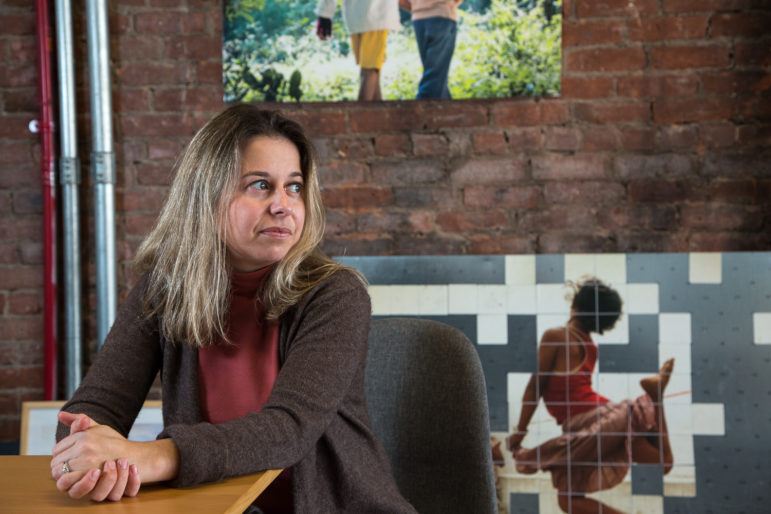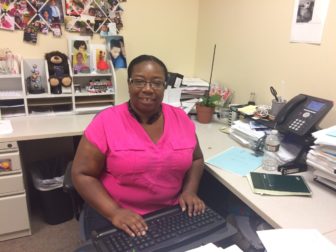In the weeks before Bridgeport police rescued the teenager from the motel, she’d been forced by her pimp to have two tattoos identifying her as belonging to him inked on her face and neck. She’d been given morphine and crack. And she’d been sold on the internet, she told police, “to over 50 or 60 dirty men.”
The girl, who was 17 when she was pulled from “the life” on Aug. 26, 2015, is one of more than 650 children and adolescents referred to the state Department of Children and Families (DCF) as victims of sex trafficking since 2008. Nearly one-third of those were referred last year alone, a result of the state’s ramping up its anti-exploitation efforts.

Derek Torrellas Photo.
The internet has changed predators’ access to youth, said Erin Williamson, of Love146, New Haven.
Prosecutions of sex traffickers are also up. Of the 38 since 2006, 10 have occurred since November 2015, when then Connecticut U.S. Attorney Deirdre Daly formed the Human Trafficking Task Force. The group combines criminal justice officials and national, state and local law enforcement, collaborating with social service agencies, to focus on those who sexually exploit children for profit.
Of the 202 children referred to DCF last year, 75 were 15- and 16-year-olds, and 12 were 11 or 12. One was 10. The youngest trafficked child ever referred to the agency was 2, said Tammy Sneed, who leads its trafficking initiatives.
The proportion of white, African American and Hispanic children was roughly equal last year, although, at 37 percent, or 74, slightly more white children were referred to the department.
Although the victims were overwhelmingly girls, Sneed and others think the lower number of boys—17 boys and one transgender youth were referred to DCF in 2016—proves only that people are less likely to recognize males as targets of sex traffickers.
In fact, general incredulity that Connecticut children would ever be trafficked hurts efforts to eradicate it, advocates and others say, noting that many people still see the problem as confined to Third World countries and cultures.
“The bulk of our work is the domestic minors, and that’s what people don’t understand,” said Brian Sibley Sr., New Haven-based senior assistant state’s attorney and lead prosecutor with the trafficking task force.
He said there’s another thing people don’t understand: “When it’s minors, it’s not prostitution. It’s the systematic abuse and rape of kids.”
Ignorance And Denial
The misconceptions are compounded by most adults’ ignorance of social media, through which the trade is overwhelmingly conducted.
“The internet has completely changed predators’ access to youth, youths’ vulnerabilities and the hidden nature of the crime,” said Erin Williamson, U.S. survivor care program director of Love146, in New Haven. Love146 is an international nonprofit dedicated to ending child sex trafficking.

iStock Photo.
More than 650 children and adolescents have been referred to DCF since 2008.
Not only are victims advertised through websites—advocates say Backpage.com has replaced Craigslist in popularity and notoriety in this regard—but social media, from Facebook to otherwise innocuous messaging apps, gives traffickers access to anyone with a cellphone.
“We’ve seen kids from all over the state being victimized: single-parent families, two-parent families, urban, rural,” Sneed said. Many have been involved with DCF, she said, but more than 40 percent have not.
“Kids with prior experience with sexual abuse are at higher risk,” she said, “but kids in general, just being an adolescent puts these kids at risk.
Traffickers used to seek young victims at malls or near schools, in parks or fast food restaurants. But the stalking has moved online.
“What [parents] don’t realize is that the culture we used to live in is no longer the same,” said Latoya Lowery, a supervisor in DCF’s Norwalk office.
Online dating has been “normalized,” she said, noting that the parents of many children met online. Adolescents’ practice of sharing personal information with expanding groups of “friends,” at least some of whom they don’t actually know, makes them extraordinarily vulnerable.
“You have kids who don’t understand the other side of this world,” Lowery said.
“Predators are starting conversations with 10, 20, 40 kids all at once on the internet,” Williamson said. “They’re able to throw out all these reels and see who bites and then they work on that rod.
“I do this for a living and I struggle to keep up because apps are always changing,” she admitted. “You end up with parents, school officials and teachers, all sorts, who just say, ‘I’m totally overwhelmed. It’s a world I don’t understand.’”
Love146 has created a curriculum explaining traffickers’ tactics and helping youths learn to protect themselves, but only about a half-dozen Connecticut school districts have offered it, the organization said.
A related impediment to stopping traffickers is that their method of luring victims, termed “recruiting and grooming,” is often not seen for what it is. This involves an exploiter’s playing to a victim’s needs and convincing her that he cares for her.
Jillian Gilchrest, head of the state Trafficking in Persons Council and a director at the Connecticut Coalition Against Domestic Violence, noted the similar dynamics of domestic violence and trafficking.
“A trafficker will actually position himself as a boyfriend to his victims, and/or abuse his victim or isolate his victim,” Gilchrest said.
“That commitment or bond with the trafficker … is very, very common,” DCF’s Sneed said. “When we do training, we talk about trauma bonds or Stockholm syndrome.”
After being rescued, survivors often have long-lasting and complex health challenges, Williamson said. A girl may need to be administered a rape kit, tested for pregnancy and sexually transmitted diseases. Victims may have been using drugs or alcohol to cope with their trauma, or substance abuse may have predated victimization, she said.
Post-trauma psychological issues may be even more complicated. “A number have histories of mental health issues, some diagnosed, some not. PTSD is real for some of our youth,” said Williamson.
Challenges
Although Connecticut passed a sex trafficking law in 2006, the first state convictions didn’t occur until the legislature tightened the law in 2016. In their 2017 session, lawmakers created the new crime of commercial sexual abuse of a minor and made it a class A or B felony. A convicted trafficker could get as much as 20 or 25 years, depending on the victim’s age.

Jenifer Frank Photo.
Latoya Lowery said that children who share information online are extremely vulnerable to predators.
Between stiffer state laws and the formation of the Human Trafficking Task Force, said Sibley, the senior assistant state’s attorney, state and federal officials are working together more effectively to coordinate cases and maximize penalties.
In August, Brandon Williams of Bridgeport, the sex trafficker who tattooed his 17-year-old victim, was sentenced to more than six years in federal prison, followed by four years of supervised release. The Bridgeport Police Department, FBI and the investigative arm of the U.S. Department of Homeland Security had worked together on the investigation.
In addition to Williams, two other child traffickers have been sentenced so far in 2017. Two others are to be sentenced shortly, another is slated for trial, and another, an East Hartford man, has been indicted.
In 2016, Connecticut became the first state to require hotels to train employees so they can recognize trafficking on the premises and to require them to post signage about trafficking. Since then, the list of establishments that must post signs has been expanded to include massage parlors, emergency facilities and other public places.
A map of sex trafficking arrests in Connecticut during the past 10 years would show them occurring frequently at lodging establishments on highways near larger cities, but also along Route 15 and all the interstates.
FBI Special Agent Wendy Bowersox said, “95 is definitely one of our hotspots,” from the New York line to the casinos.
Advocates and law enforcement all say that even communities considered middle class have trafficking.
Listing establishments off I-95 at exits 35, 36, 39 and 40, Officer Michael DeVito of the Milford Police Department said, “We have a dozen hotels in close proximity. It’s very safe to say that [trafficking arrests] very likely and consistently occur once a month.”
Tips On Reporting, Spotting Trafficking
To report a child being victimized in Connecticut, call the Careline at 1-800-842-2288.
Trafficking victims can text “BEFREE” (233733) for an immediate response and help from the National Human Trafficking Resource Center.
National Human Trafficking Resource Center Hotline – 888-373-7888
National Center for Missing and Exploited Children
Polaris Project on Human Trafficking

Public ignorance can only be blamed on the state and federal agencies. You all suck.